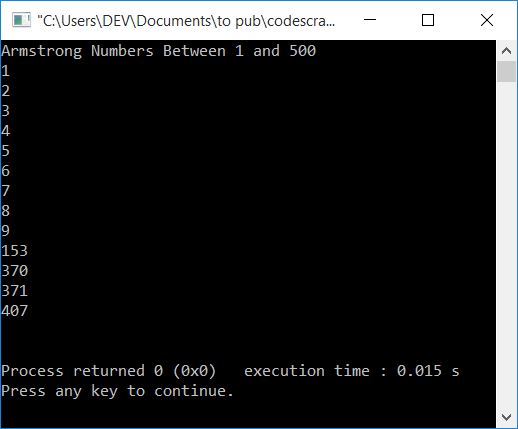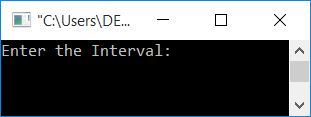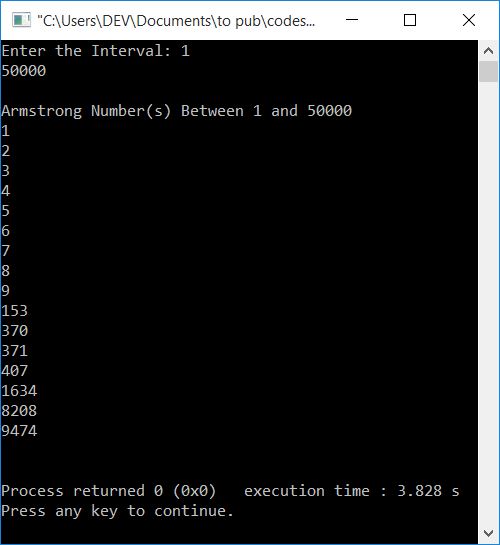- C++ Programming Examples
- C++ Programming Examples
- C++: Hello World
- C++: Get Input
- C++: Print Integer
- C++: Add two numbers
- C++: Add, Sub, Multiply, Div
- C++: Add Digits
- C++: Find Average and Percentage
- C++: Find Arithmetic Mean
- C++: Sum of n Natural Numbers
- C++: Sum of n Numbers
- C++: Square's Area and Perimeter
- C++: Rectangle's Area and Perimeter
- C++: Triangle's Area and Perimeter
- C++: Area and Circumference
- C++: Find Simple Interest
- C++: Fahrenheit to Celsius
- C++: Celsius to Fahrenheit
- C++: Print Prime Numbers
- C++: Reverse a Number
- C++: Swap Two Numbers
- C++: Print Multiplication Table
- C++: Find Factorial of a Number
- C++: Find Factors of a Number
- C++: Find HCF and LCM
- C++: Create a Calculator
- C++: Count Digits in a Number
- C++: First and Last Digit Sum
- C++: Product of Number Digits
- C++: Sum of Squares of Digits
- C++: Interchange Digits of Number
- C++ if-else Programs
- C++: Check Even or Odd
- C++: Check Prime or Not
- C++: Check Alphabet or Not
- C++: Check Vowel or Not
- C++: Check Leap Year or Not
- C++: Check Reverse equals Original
- C++: Check Perfect Number
- C++: Check Palindrome or Not
- C++: Check Armstrong or Not
- C++: Divisibility Test
- C++: Find Labor Wage
- C++: Find Discounted Price
- C++: Find Shipping Charge
- C++: Find Telephone Bills
- C++: Calculate Student Grade
- C++: Largest of Two Numbers
- C++: Largest of Three Numbers
- C++ Number Conversion
- C++: Decimal to Binary
- C++: Decimal to Octal
- C++: Decimal to Hexadecimal
- C++: Binary to Decimal
- C++: Binary to Octal
- C++: Binary to Hexadecimal
- C++: Octal to Decimal
- C++: Octal to Binary
- C++: Octal to Hexadecimal
- C++: Hexadecimal to Decimal
- C++: Hexadecimal to Binary
- C++: Hexadecimal to Octal
- C++ Pattern Programs
- C++: Pattern Programs
- C++: Print Diamond Pattern
- C++: Print Floyd's Triangle
- C++: Print Pascal's Triangle
- C++ Array Programs
- C++: 1D Array Program
- C++: Linear Search
- C++: Binary Search
- C++: Largest Element in an Array
- C++: Smallest Element in an Array
- C++: Find Second Largest Element
- C++: Find Second Smallest Element
- C++: Sum of All Elements
- C++: Multiply All Elements
- C++: Element in Even Position
- C++: Element in Odd Position
- C++: Print Even Numbers in Array
- C++: Print Odd Numbers in Array
- C++: Count Even or Odd Numbers
- C++: Sum of Even or Odd Numbers
- C++: Count Positive, Negative, Zero
- C++: Reverse an Array
- C++: Insert an Element
- C++: Delete an Element
- C++: Merge two Arrays
- C++: Bubble Sort
- C++: Selection Sort
- C++: Insertion Sort
- C++: Common Elements
- C++: 2D Array Programs
- C++: Add Two Matrices
- C++: Subtract Two Matrices
- C++: Transpose Matrix
- C++: Multiply Two Matrices
- C++: 3D Array Programs
- C++ String Programs
- C++: Print String
- C++: Find String Length
- C++: Compare Two Strings
- C++: Copy String
- C++: String Concatenation
- C++: Reverse a String
- C++: Delete Vowels from a String
- C++: Delete a Word from a String
- C++: Count Characters in a String
- C++: Count Words in a String
- C++: Frequency of Words
- C++: Remove Spaces from Strings
- C++: Sort a String
- C++: Uppercase to Lowercase
- C++: Lowercase to Uppercase
- C++: Swap Two Strings
- C++: Check the Anagram or Not
- C++: Capitalize All Words in a String
- C++: Get Numbers from a String
- C++ File Programs
- C++: Read a File
- C++: Write Content to a File
- C++: Append Data to a File
- C++: Read and Display File
- C++: Copy a File
- C++: Merge Two Files
- Count Characters in a File
- C++: Capitalize Every Word
- C++: List Files in Directory
- C++: Delete a File
- C++: Encrypt and Decrypt a File
- C++ Misc Programs
- C++: Print ASCII Value
- C++: Add Binary Numbers
- C++: Generate Random Numbers
- C++: Print a Smiling Face
- C++: Days into Years and Months
- C++: Add Two Numbers using Pointer
- C++: Print Fibonacci Series
- C++: Generate Armstrong Numbers
- C++: Find nCr and nPr
- C++: Get IP Address
- C++: Print Date and Time
- C++: Shutdown and Restart Computer
- C++ Programming Tutorial
- C++ Tutorial
C++ Program to Generate Armstrong Numbers
In this article, you will learn and get code to generate and print Armstrong numbers in C++ programming. Here is the list of programs available here:
- Print Armstrong numbers between 1 and 500
- Print Armstrong numbers in the given range. The user must supply the range at run-time.
What is an Armstrong number?
A number that equals the sum of its own digits, where each digit is raised to the power of the number of digits. For example, 8208 is an Armstrong number because:
8208 = 84 + 24 + 04 + 84
= 4096 + 16 + 0 + 4096
= 4096 + 16 + 4096
= 8192 + 16
= 8208
The result is equal to the number itself. So it is an Armstrong number.
Note: Because the total number of digits in 8208 is 4, each of its digits is raised to the power of 4.
Print Armstrong numbers between 1 and 500
This program generates and prints all Armstrong numbers between 1 and 500.
The question is: write a program in C++ to generate and print Armstrong numbers between 1 and 500. Here is its answer:
#include<iostream> using namespace std; int main() { int first, last, temp, noOfDigit, num, res=0, rem, pow, i; first = 1; last = 500; cout<<"Armstrong Numbers Between 1 and 500\n"; while(first<=last) { temp = first; noOfDigit = 0; while(temp>0) { temp = temp/10; noOfDigit++; } num = first; while(num>0) { rem = num%10; pow = 1; i = 0; while(i<noOfDigit) { pow = pow*rem; i++; } res = res + pow; num = num/10; } if(res==first) cout<<res<<endl; first++; res = 0; } cout<<endl; return 0; }
This program was built and runs under the Code::Blocks IDE. Here is its sample run:

The program uses a while loop that starts with 1 and ends with 500. And each time the value of first is set to temperature. Now we've calculated the number of its digits. Then it checks whether the value of temp is an Armstrong number or not. If it is an Armstrong, then it prints its value as output; otherwise, the same process continues to check with the next number until the value of the first becomes greater than the last.
Please refer to the Armstrong number for more information.
Print the Armstrong number within the given range
To generate and print Armstrong numbers in a given range given by the user, using C++ programming, you have to ask the user to enter the interval. Then apply the same process as given in the previous program.
The only difference is that the program receives the value of first and last here.
#include<iostream> using namespace std; int main() { int first, last, temp, noOfDigit, num, res=0, rem, pow, i; cout<<"Enter the Interval: "; cin>>first>>last; cout<<"\nArmstrong Number(s) Between "<<first<<" and "<<last<<endl; while(first<=last) { temp = first; noOfDigit = 0; while(temp>0) { temp = temp/10; noOfDigit++; } num = first; while(num>0) { rem = num%10; pow = 1; i = 0; while(i<noOfDigit) { pow = pow*rem; i++; } res = res + pow; num = num/10; } if(res==first) cout<<res<<endl; first++; res = 0; } cout<<endl; return 0; }
Here is its sample run. This is the initial output produced by the above program:

Now enter the interval, say 1 and 50000, to print all Armstrong numbers between 1 and 50000 as shown in the snapshot given below:

The same program in different languages
« Previous Program Next Program »